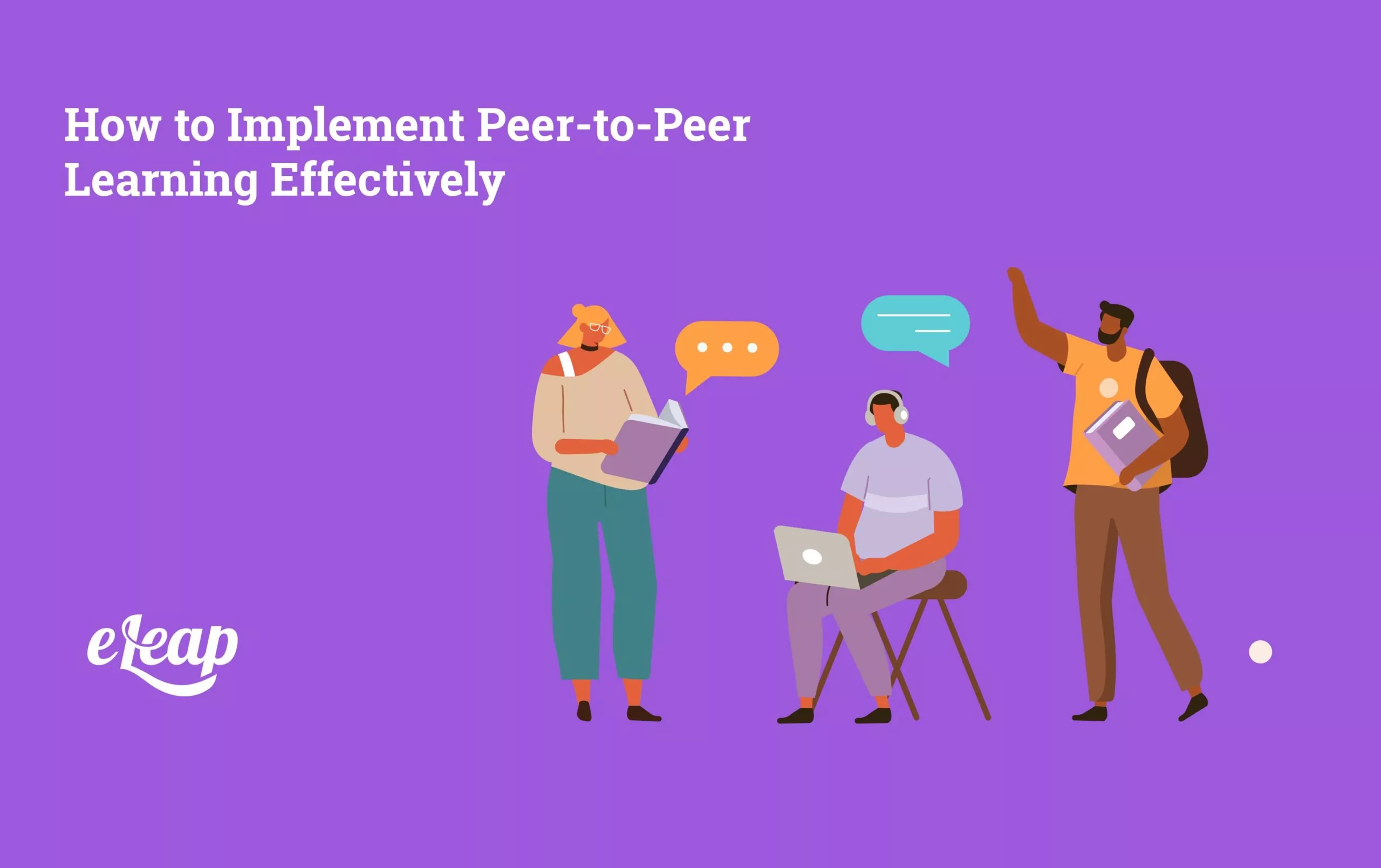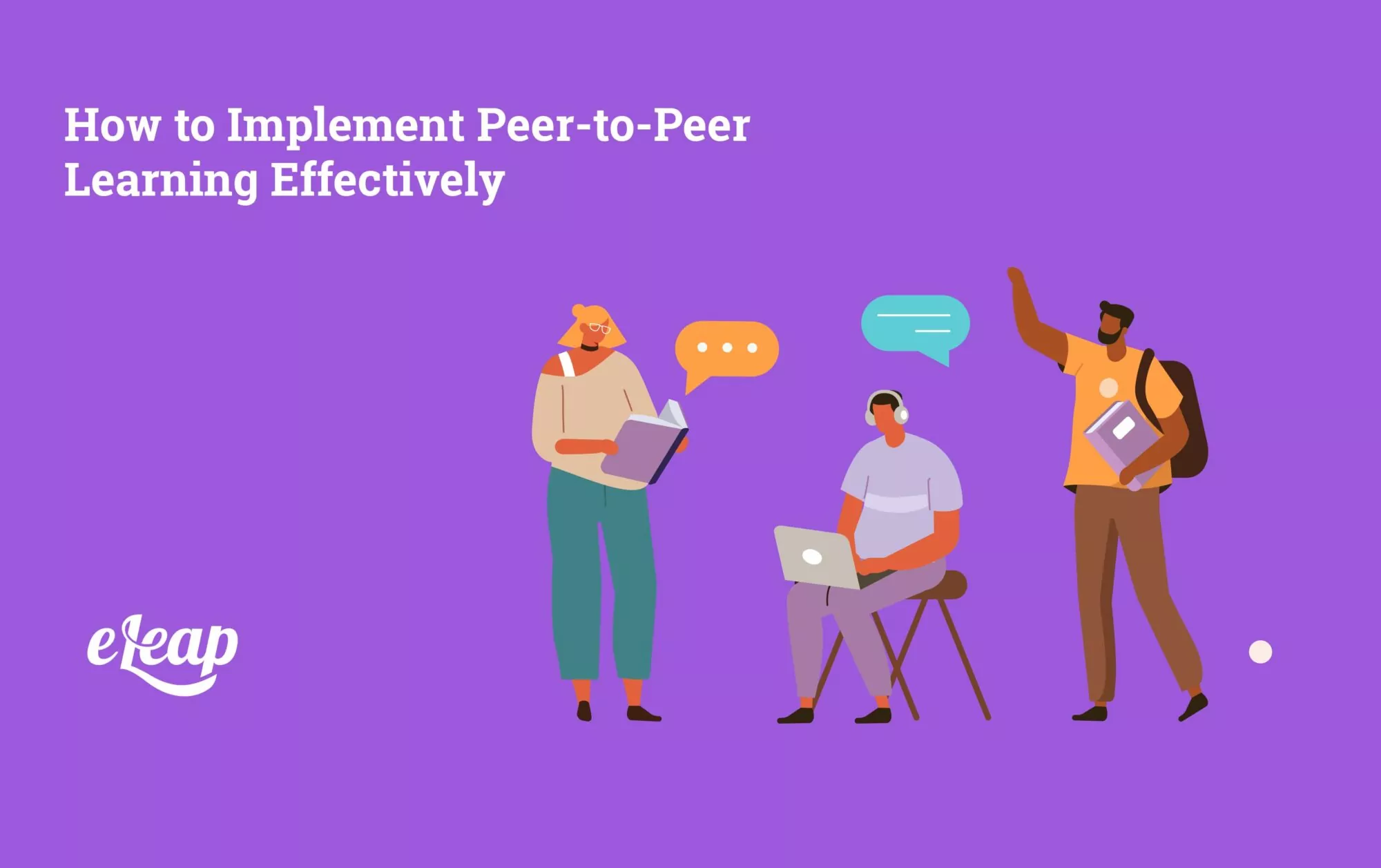How to Implement Peer-to-Peer Learning Effectively: A Complete Guide

Peer-to-peer learning (P2P) is an educational model that promotes direct interaction between learners. This approach, built on collaboration and knowledge-sharing, has proven to be an effective strategy across various industries and academic institutions. Whether you’re a business professional looking to enhance team performance or an educator wanting to foster better engagement in the classroom, understanding how to implement peer to peer learning effectively can lead to significant improvements in learning outcomes and employee development. See how eLeaP®’s Performance Management Platform helps you apply these insights to drive better results.
This article will explore how to effectively implement peer-to-peer learning, its benefits, strategies for successful integration, common challenges, and real-world examples that demonstrate its success.
What Is Peer-to-Peer Learning?
At its core, peer-to-peer learning is an instructional strategy where individuals learn from each other. Unlike traditional models, where one expert typically imparts knowledge to many students, P2P learning involves people engaging with one another at the same learning level. This process might include employees helping colleagues, students collaborating on projects, or experts sharing their experiences with those less experienced.
This model encourages interaction, discussion, and practical application of knowledge, all of which help deepen understanding. Peer to peer learning can occur in formal settings, such as classrooms and corporate training programs, or informal ones, like workplace mentoring or study groups.
Why Peer-to-Peer Learning Matters in Today’s World
Peer-to-peer learning is increasingly relevant in both educational and professional environments. It offers businesses an efficient way to upskill employees, enhance collaboration, and improve team performance. Education creates an environment where students actively participate in learning, moving away from passive information consumption.
Peer-to-peer learning is essential because it makes learning more dynamic and participatory. However, its benefits go beyond knowledge transfer. When employees or students collaborate, they develop crucial skills like communication, problem-solving, and leadership, which are key components of personal and professional growth.
The Benefits of Peer-to-Peer Learning
Promotes Deeper Learning and Knowledge Retention
One of the most compelling reasons for implementing peer to peer learning is its ability to enhance knowledge retention. Studies have shown that learners remember information better when actively engaging with it, especially when explaining or teaching it to someone else. This “learning by teaching” principle is a powerful driver of deeper understanding.
When peers explain complex concepts to each other, they must process the information clearly and understandably. This deeper level of engagement strengthens retention and understanding.
Increases Engagement and Motivation
Peer-to-peer learning fosters an environment where individuals feel more accountable to one another. This accountability is motivating, as learners or employees are more likely to participate actively when they know their peers rely on them for insights or explanations.
Moreover, peer learning eliminates the monotonous, one-sided lecture format often seen in traditional teaching or training methods. By allowing for collaborative problem-solving and discussion, P2P learning increases engagement and reduces the likelihood of disengagement.
Cultivates Leadership and Communication Skills

A peer-to-peer learning environment naturally encourages the development of leadership and communication skills. Peer leaders, whether students or employees, must demonstrate effective communication, provide constructive feedback, and manage group dynamics. These are all qualities that are transferable to other professional environments.
Employees who regularly engage in peer-to-peer learning are often seen as more effective collaborators and leaders in the workplace. As they mentor others or lead group discussions, they hone their ability to express ideas clearly, motivate others, and solve conflicts—skills that are crucial in any professional setting.
Supports Lifelong Learning and Development
One of the significant advantages of peer-to-peer learning is that it supports lifelong learning. Since peer learning typically involves ongoing, collaborative relationships, it encourages continuous development. The informal nature of peer learning helps employees or students remain curious, adaptable, and open to new ideas, making staying updated on trends and advancements in their fields easier.
Key Strategies to Implement Peer-to-Peer Learning Successfully
Designing a Structured Peer-to-Peer Learning Program
Designing a structured program is crucial to implementing peer to peer learning effectively. While peer learning is inherently informal, creating a framework that clearly defines roles, expectations, and objectives ensures that participants stay on track. The goal is to blend the benefits of collaborative learning with the organizational structure necessary to maintain focus and productivity.
Start by setting clear objectives for the peer learning program. What specific skills or knowledge should participants gain from the experience? Defining these objectives will help guide the design of activities, peer assignments, and assessments.
Integrating peer-to-peer learning into existing training or educational programs can help streamline the process. For example, you can incorporate peer learning activities in onboarding programs, professional development workshops, or classroom lessons.
Identifying and Training Effective Peer Leaders
Peer leaders are essential to the success of the peer to peer learning model. They should be well-equipped to guide discussions, answer questions, and facilitate knowledge exchange. Therefore, it’s essential to carefully select peer leaders based on their communication skills, subject knowledge, and interpersonal abilities.
Once chosen, peer leaders need training in managing group dynamics, providing constructive feedback, and handling challenging situations. Training should also emphasize the importance of fostering an inclusive environment where all participants feel comfortable sharing their thoughts and ideas.
Leveraging Technology to Facilitate Peer-to-Peer Learning
Technology is essential for enabling effective peer-to-peer learning in the modern workplace or classroom. Digital tools such as learning management systems (LMS), collaboration platforms, and communication apps can facilitate seamless peer interaction, even in remote or hybrid environments.
For instance, eLeaP, an advanced learning management platform, provides tools that support peer learning by allowing employees or students to share knowledge through forums, video conferences, and collaborative spaces. This technology can help break down geographical barriers and ensure continuous engagement regardless of location.
Best Practices for Successful Peer-to-Peer Learning
Fostering a Collaborative and Inclusive Culture
A thriving peer-to-peer learning environment is built on mutual respect and collaboration. Creating a culture where all participants feel valued and heard is essential. This means fostering inclusivity, ensuring each participant has an equal opportunity to contribute, and encouraging diverse perspectives.
Encourage an environment where participants share knowledge and learn from each other’s experiences. This collaborative approach enhances learning outcomes, improves team dynamics, and strengthens interpersonal relationships.
Clear Expectations, Roles, and Responsibilities
It’s crucial to set clear expectations for both peer leaders and learners. Ensure everyone understands their roles, the objectives of the peer learning sessions, and how their contributions will be evaluated. Establishing these guidelines upfront helps prevent misunderstandings and ensures everyone is on the same page.
Clear roles also facilitate the identification of those who need additional support or resources. This proactive approach ensures the program’s success.
Continuous Feedback and Improvement
Feedback is essential for the success of any learning program, including peer to peer learning. Encourage participants to provide constructive feedback on each other’s performance and the overall experience. The feedback should help everyone improve.
Regularly evaluating the success of the peer to peer learning program will help identify areas for improvement. Whether through surveys, one-on-one check-ins, or group discussions, gathering feedback will ensure the program continues to meet its objectives and evolve.
Common Pitfalls in Peer-to-Peer Learning (and How to Avoid Them)
Overcoming Resistance to Peer Learning
One common challenge with peer-to-peer learning is initial resistance, especially in traditional corporate or academic environments. Some employees or students may feel uncomfortable sharing their knowledge or be skeptical about its effectiveness.
To overcome this, it’s essential to communicate the benefits clearly and address any concerns upfront. Offer examples of successful peer learning programs and encourage open dialogue about potential challenges.
Ensuring Balanced Participation and Fairness
In peer learning environments, it is essential to ensure that all participants are engaged equally. Specific individuals may sometimes dominate the conversation, leaving others less involved. One way to counter this is to assign specific roles or tasks to each participant, ensuring everyone contributes.
Also, consider rotating group members regularly to ensure a diverse exchange of ideas and prevent the formation of cliques.
Evaluating Effectiveness and Measuring Success
To ensure the success of your peer-to-peer learning initiative, it’s vital to evaluate its effectiveness. This can be done through surveys, quizzes, or tracking the completion of learning milestones. By measuring the program’s success, you can make informed adjustments and continually improve its impact.
Case Studies: Peer-to-Peer Learning in Action
Corporate Case Study: Using Peer Learning to Boost Employee Skills
Many companies are now leveraging peer-to-peer learning to enhance employee development. For example, a large tech company introduced a peer mentoring program where senior engineers worked closely with new hires. This process allowed the new employees to quickly gain technical knowledge while senior staff honed their leadership skills.
Using eLeaP to track progress and provide resources, the company could monitor the program’s success and make adjustments as necessary. As a result, employee retention and engagement improved significantly.
Educational Case Study: Peer Learning in Schools and Universities
In education, peer-to-peer learning has been adopted to foster collaboration and enhance student outcomes. A prominent university integrated peer-led study groups into its curriculum, allowing students to collaborate on assignments and prepare for exams together.
This stage improved academic performance and created a community within the student body. Faculty used peer feedback to refine the program and ensure its continued success.
How to Get Started with Peer-to-Peer Learning in Your Organization or Classroom
Step-by-Step Guide to Launching a Peer-to-Peer Learning Program
- Define the goals of the program and select appropriate peer leaders.
- Choose the right tools and platforms to facilitate communication and collaboration.
- Set clear expectations and roles for all participants.
- Implement regular feedback mechanisms to track progress and make improvements.
Overcoming Initial Challenges and Ensuring Long-Term Success
Be patient and flexible to ensure the long-term success of your peer to peer learning program. Initially, you may face challenges such as resistance or lack of engagement, but these obstacles can be overcome with consistent effort and fine-tuning.
Conclusion
Implementing peer-to-peer learning effectively can unlock many benefits for businesses, educational institutions, and individual learners. Creating a structured, inclusive, and collaborative learning environment ensures that your team or students gain new knowledge and develop essential skills like leadership, communication, and teamwork.
Following the strategies outlined in this article, you can set up a peer-to-peer learning program that fosters growth, engagement, and long-term success.